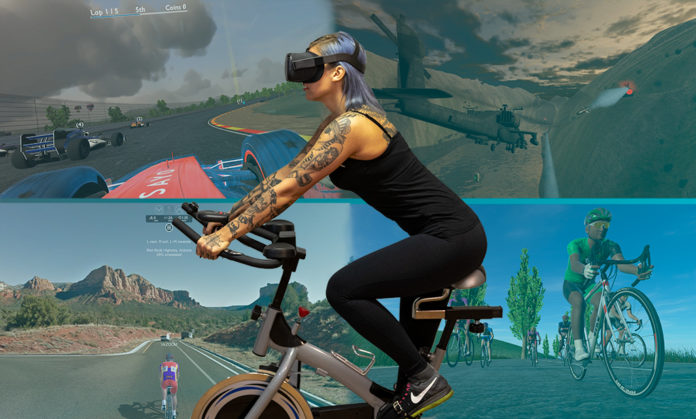Virzoom, the creative force behind the excellent VZFit, has announced a significant evolution of their product today as continued improvements to third party Bluetooth cadence sensors has allowed them to cease production of their own propriety VZFit hardware solution.
Posting on their blog and Facebook page Virzoom explained how this natural development has arisen. Thanks to the continued improvements within the virtual reality industry, combined with the growing popularity of indoor cycling generally, (Zwift and Pelaton, in particular, have both firmly entered the mainstream consciousness), there now exists a solid third party infrastructure through which a consumer can connect their compatible VR headset to any stationary bike. In short, the VZFit hardware was no longer needed.
The evolution of a company, and an industry
In Virzoom’s evolution as a company, we can trace the relatively rapid development of the VR industry itself. As they wrote in their announcement ‘ In 2014 when we started trying to tackle HOW we would get biking to work in VR, the only solution was to design the bike ourselves. With the announcement of wireless headsets, like the Quest and Go, we realized there would soon be a wider audience and that wireless headsets made the most sense for fitness applications. We took everything we learned with the VirZOOM bike, and squeezed it into a sensor and button that could be attached to any stationary bike.’
The sensor and controller made a lot of sense at the time, as Virzoom’s gamification of the stationary bike required you to be able to shoot weapons, toot your horn and make menu selections. Some of their game modes required the ability to reverse as well and there wasn’t a single third party solution that they could recommend to consumers to buy that would enable them to do all of this. So, reluctantly they built their own.
Why the VZFit hardware solution was never ideal
VZFit’s hardware solution is an excellent product. It does everything it set out to do, but there are several significant drawbacks which likely hampered sales, and put off potential customers. The first was cost. Being a small VR software company, Virzoom was not ideally placed to develop a hardware product. They were able to partner with some excellent hardware companies but producing a bespoke system cost money that needed to be passed on to the consumer. At $99 for the kit, plus a substantial customs hit if you lived outside of the US and Canada the system represented a sizeable initial investment. This soured the taste for some consumers who felt that after paying out for the hardware, the monthly subscription cost to access the full service was an unjustified extra expense. The other drawback to the VZFit sensor was that being propriety it doesn’t work with other bike applications and services. Thus an important goal for Virzoom this year was to make the VZFit software compatible with third-party sensors, achieved via an update in March 2020.
As Virzoom write of this change, ‘When we started testing third party hardware, we were surprised to see how far these sensors and trainers had come and were delighted to discover that they could provide a great experience when playing our games, which is the most important part for us.
The reception to this change has been amazing. We have had current customers try it and love the integration, and more than half of our new customers are now using non-VZfit sensors.’
This rapid and positive embrace of third-party solutions by their customers, along with valuable customer feedback on their forums as to the reliability and quality of the third party sensor experience has emboldened Virzoom to take the decision to leave the production of the hardware to companies that specialize in that and spend all their own time and resources on what really matters, the VZFit software, the Play, and Explorer apps.
The benefits of embracing the third party market
For the consumer, the biggest advantage is the cost savings. The most affordable third party solutions can be had for around $25 or less. As I’ll be covering in an upcoming article I’ve been having a great experience using an IGPSport C61 sensor that I got delivered from eBay for just £16. The other big gain is compatibility with other VR services such as Holodia’s Holofit as well as traditional solutions like Zwift. It’s likely that some consumers will have a compatible sensor already, and with one sensor allowing connectivity to different services consumers are more likely to pick one up out of curiosity.
If, like me, you own the VZFit hardware, rest assured that Virzoom has stated all future software updates will continue to fully support their own hardware alongside third-party sensors.

VZFit continues to get better, with full smart bike integration planned
With the retirement of the VZFit hardware, Virzoom is now fully able to focus on making their software the best it can be. To that end, there are some exciting upcoming developments.
From the Virzoom team, ‘As we go forward, we will be adding support for Power Bluetooth profiles in the next update, which will allow older and mid-level trainers devices to work with our apps. After that, full Smart Bike/Trainer integration is on the way, which will bring with it the ability to control resistance on smart bikes and trainers that support it. Those hills and mountain rides are going to get a lot more real feeling.’.
Final thoughts
In the eight or nine months I’ve been using VZfit it’s come a long way. Regular updates have added features like in-game music, new game levels, and an array of enhancements to VZFit Explorer, the Google Streetview cycling app that has become one of the definitive VR exercise experiences. As I recently covered it now has official scientific backing, a recently published article in the British Journal of Health Psychology showing it’s increased benefits over traditional exercise modalities for increasing enjoyment, improving positive associations with exercise, and helping participants to train for longer.
Now the software is easier than ever to access, the cost of entry significantly lowered. This is great news for developers Virzoom of course, but also a testament to how far VR has come in just a few years. Like many, I sometimes get frustrated at the relatively slow adoption of VR and the fact a true second-generation PCVR headset has yet to be released.
But in retrospect, if you’d have told me in 2015 that by 2020 I’d be able to ride my as then completely unused and abandoned stationary bike in virtual reality from my own house out into the countryside, on a standalone headset that required no computer and could work anywhere I’d have thought that about as believable as Elon Musk’s claim that a neural link implant will mean we’ll be able to communicate telepathically within the next decade…
VR is advancing, VR fitness is advancing, and companies like Virzoom are leading the way.











